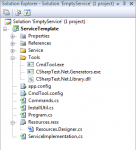Keeping in line with our previous post “How to prevent users from killing your service or process” and continuing down the road of securing our service this post looks at the prevention of debugging. There are a lot of anti-debugging posts out there, most of them written in C++ and assembly and are therefor of [...]
Before I say another word, I have read “The arms race between programs and users” and wholeheartedly agree. You can not, and should not, attempt to stop an Administrator from killing your process or stopping your service. That is not what we are trying to do here, we are trying to prevent Joe User from [...]

Continued from “Building a Windows Service – Part 6: Adding resources and event logging” So let’s recap our goals for this project: Building a service that can also be used from the console Proper event logging of service startup/shutdown and other activities Allowing multiple instances by using command-line arguments Self installation of service and event [...]

Continued from “Building a Windows Service – Part 5: Adding command-line installation” So we have a working service it’s time to start adding some logging. Proper event logging is critical to monitoring services so we are not going to use .NET’s typical excuse for events. Rather we are going to build a ‘real’ message dll [...]
Continued from “Building a Windows Service – Part 4: Extending the Service Installer” So with our installer working it would be nice to have a way to just run the install right from the command-line. There are several options here, one way would be to use the Process object, set the start parameters to not [...]
Continued from “Building a Windows Service – Part 3: Creating a Service Installer” In the previous post we created a rough draft of our service installer. In this post we will focus on extending the capabilities of the default ServiceInstaller class and enhancing the behavior of the default class. Here are the goals: Use declarative [...]
Continued from “Building a Windows Service – Part 2: Adding a Service to a Console Application” We are going to take this in two steps, first the minimal we need to do to make something *sorta* work, then we are going to get fancy. This post will focus on the first part, making something work. [...]

Continued from “Building a Windows Service – Part 1: Getting started” So now that we’ve built ourselves a console application it’s time to add the service. Doing this is strait-forward and we can use the Visual Studio template for both the service and a basic installer. The first thing I’ve done is to create a [...]

This is the first of what I hope to be a multi-part deep-dive into building managed Windows services. As with any task the first thing we need to discover is the why and what for. Services can be very useful for a number of situations. On the client side of things one might be using [...]
So I ran into this article entitled “How to Create a Personal Encryption Scheme to Easily Hide Your Data in Plain Sight” on lifehacker. I just want to say: This is a REALLY bad idea. The recommendation is to create you’re very own personal ‘encryption‘ system to encode you’re personal information in plain site. The [...]